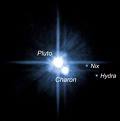 Close Topic Options
Close Topic OptionsPluto - Page 4 of 6
You'll get bored after awhile no matter - Page 4 - Sciences, Education, Art, Writing, UFO - Posted: 2nd Jun, 2016 - 8:47pm
Page 4 Pluto
Plutos hulk-like Moon Charon: A Possible Ancient Ocean
Science Related News
Pluto's largest moon may have gotten too big for its own skin. Images from NASA's New Horizons mission suggest that Pluto's moon Charon once had a subsurface ocean that has long since frozen and expanded, pushing outward and causing the moon's surface to stretch and fracture on a massive scale.
Source
Pluto
What's eating at Pluto?
Far in the western hemisphere, scientists on NASA's New Horizons mission have discovered what looks like a giant "Bite mark" on Pluto's surface. They suspect it may be caused by a process known as sublimation -- the transition of a substance from a solid to a gas. The methane ice-rich surface on Pluto may be sublimating away into the atmosphere, exposing a layer of water-ice underneath, they report. Ref. Source 9q.
Pluto
Pluto's polygons may have been formed by convection
On Pluto, icebergs floating in a sea of nitrogen ice are key to a possible explanation of the quilted appearance of the Sputnik Planum region of the dwarf planet's surface. Researchers have proposed that the polygons seen in the images could be individual Rayleigh--Bénard convection cells. Ref. Source 5y.
 TOPIC: Pluto
TOPIC: Pluto